AIDER: Aircraft Icing Potential Area DEtection in Real-Time Using 3-Dimensional Radar and Atmospheric Variables
Abstract
:1. Introduction
2. Data
3. Characteristics of Radar and Atmospheric Variables in Icing Environments
4. Algorithm for Detecting of Icing Potential
5. Results and Verification
6. Case Studies
6.1. Icing Associated with Low Pressure and Fronts
6.2. Icing in Stratiform Clouds
6.3. Icing in Cumuliform Clouds
7. Conclusions
8. Patents
Author Contributions
Funding
Data Availability Statement
Conflicts of Interest
References
- Federal Aviation Administration (FAA). Part 25: Airworthiness Standards: Transport Category Airplanes: Appendix C. Title 14: Code of Federal Regulations; Office of the Federal Register, National Archives and Records Administration: Washington, DC, USA, 2009; Volume 74, pp. 38340–38341.
- Thompson, G.; Politovich, M.K.; Rasmussen, R.M. A numerical weather model’s ability to predict characteristics of aircraft icing environments. Weather Forecast. 2017, 32, 207–221. [Google Scholar] [CrossRef]
- Schultz, P.; Politovich, M.K. Toward the improvement of aircraft-icing forecasts for the continental United States. Weather Forecast. 1992, 7, 491–500. [Google Scholar] [CrossRef]
- Forbes, G.S.; Hu, Y.; Brown, B.G.; Bernstein, B.C.; Politovich, M.K. Examination of soundings in the proximity of pilot reports of aircraft icing during STORM-FEST. In Proceedings of the 5th International Conference on Aviation Weather Systems, Vienna, VA, USA, 2–6 August 1993; pp. 282–286. [Google Scholar]
- Thompson, G.; Bruintjes, R.T.; Brown, B.G.; Hage, F. Intercomparison of in-flight icing algorithms. Part I: WISP94 real-time icing prediction and evaluation program. Weather Forecast. 1997, 12, 878–889. [Google Scholar] [CrossRef]
- Cober, S.G.; Isaac, G.A.; Strapp, J.W. Aircraft icing measurements in East Coast winter storms. J. Appl. Meteorol. Climatol. 1995, 34, 88–100. [Google Scholar] [CrossRef]
- Cober, S.G.; Strapp, J.W.; Isaac, G.A. An example of supercooled drizzle droplets formed through a collision coalescence process. J. Appl. Meteorol. 1996, 35, 2250–2260. [Google Scholar] [CrossRef]
- Cober, S.G.; Strapp, J.W.; Isaac, G.A. Characterizations of aircraft icing environments that include supercooled large drops. J. Appl. Meteorol. 2001, 40, 1984–2002. [Google Scholar] [CrossRef]
- Cober, S.G.; Bernstein, B.; Jeck, R.; Hill, E.; Isaac, G.; Riley, J.; Shah, A. Data and Analysis for the Development of an Engineering Standard for Supercooled Large Drop Conditions. US Department of Transportation Final Report, DOT/FAA/AR-09/10. 2009, 77p. Available online: http://www.tc.faa.gov/its/worldpac/techrpt/ar0910.pdf (accessed on 1 March 2009).
- Hauf, T.; Schröder, F. Aircraft icing research flights in embedded convection. Meteorol. Atmos. Phys. 2006, 91, 247–265. [Google Scholar] [CrossRef]
- Cober, S.G.; Isaac, G.A. Characterization of aircraft icing environments with supercooled large drops for application to commercial aircraft certification. J. Clim. Appl. Meteorol. 2012, 51, 265–284. [Google Scholar] [CrossRef]
- Federal Aviation Administration. Parts 25 and 33: Airplane and Engine Certification Requirements in Supercooled Large Drop, Mixed Phase, and Ice Crystal Icing Conditions; Final Rule; Office of the Federal Register, National Archives and Records Administration: Washington, DC, USA, 2014; Volume 79, pp. 65508–65540. Available online: https://www.gpo.gov/fdsys/pkg/FR-2014-11-04/pdf/2014-25789.pdf (accessed on 4 November 2014).
- Augros, C.; Lecocq, M.; Riette, S.; Le Bot, C.; Gaussiat, N. Signatures of supercooled liquid water drops in dual-polarization observations measured by ground-based radars. In Proceedings of the WMO Aeronautical Meteorology Scientific Conference, Toulouse, France, 6–10 November 2017. [Google Scholar]
- Ikeda, K.; Rasmussen, R.M.; Brandes, E.; McDonough, F. Freezing drizzle detection with WSR-88D radars. J. Appl. Meterol. Climatol. 2009, 48, 41–60. [Google Scholar] [CrossRef]
- Rauber, R.; Tokay, A. An explanation for the existence of supercooled water at the top of cold clouds. J. Atmos. Sci. 1991, 48, 1005–1023. [Google Scholar] [CrossRef]
- Ellrod, G.P.; Bailey, A.A. Assessment of aircraft icing potential and maximum icing altitude from geostationary meteorological satellite data. Weather Forecast. 2007, 22, 160–174. [Google Scholar] [CrossRef]
- Sim, S.; Im, J.; Park, S.; Park, H.; Ahn, M.H.; Chan, P.W. Icing detection over East Asia from geostationary satellite data using machine learning approaches. Remote Sens. 2018, 10, 631. [Google Scholar] [CrossRef]
- Bernstein, B.C.; McDonough, F.; Politovich, M.K.; Brown, B.G.; Ratvasky, T.P.; Miller, D.R.; Wolff, C.A.; Cunning, G. Current icing potential: Algorithm description and comparison with aircraft observations. J. Appl. Meteorol. 2005, 44, 969–986. [Google Scholar] [CrossRef]
- Tafferner, A.; Hauf, T.; Leifeld, C.; Hafner, T.; Leykauf, H.; Voigt, U. ADWICE: Advanced diagnosis and warning system for aircraft icing environments. Weather Forecast. 2003, 18, 184–203. [Google Scholar] [CrossRef]
- Doms, G.; Schättler, U. The Nonhydrostatic Limited Area Model LM (Lokal Modell) of DWD. Part I: Scientific Documentation; LM_F90 1.35; Deutscher Wetterdienst: Offenbach, Germany, 1999; 172p. [Google Scholar]
- Kalinka, F.; Roloff, K.; Tendel, J.; Hauf, T. The In-flight icing warning system ADWICE for European airspace-Current structure, recent improvements and verification results. Meteorol. Z. 2017, 26, 441–455. [Google Scholar] [CrossRef]
- Serke, D.J.; Ellis, S.M.; Tessendorf, S.A.; Albo, D.E.; Hubbert, J.C.; Haggerty, J.A. Radar Icing Algorithm: Algorithm Description and Comparison with Aircraft Observations. J. Atmos. Ocean. Technol. 2022, 39, 91–109. [Google Scholar] [CrossRef]
- Isaac, G.A.; Cober, S.G.; Strapp, J.W.; Korolev, A.V.; Tremblay, A.; Marcotte, D.L. Recent Canadian research on aircraft in-flight icing. Can. Aeronaut. Space J. 2001, 47, 213–221. [Google Scholar]
- Stuart, R.A.; Isaac, G.A. Freezing precipitation in Canada. Atmos.-Ocean 1999, 37, 87–102. [Google Scholar] [CrossRef]
- Lee, S.-J.; Kim, Y.-C. A study on the occurrence and prediction of aircraft icing over South Korea. Asia-Pac. J. Atmos. Sci. 2005, 41, 615–624. [Google Scholar]
- Kim, Y.C. The Analysis of the characteristics of Korean peninsula Aircraft Icing Index using KWRF. J. Korean Soc. Aviat. Aeronaut. 2010, 18, 42–54. [Google Scholar]
- Kim, Y.C. A Verification of threshold of the Aircraft turbulence index and Icing Index Using PIREPs and KWRF on Korean Peninsula. J. Korean Soc. Aviat. Aeronaut. 2011, 19, 54–60. [Google Scholar] [CrossRef]
- Mingione, G.; Barocco, M.; Denti, E.; Bindi, F.G. Flight in Icing Conditions. Direction Générale de l′Aviation civile (DGAC) DGAC, Tech. Rep. 1997, pp. 188. Available online: https://www.ecologie.gouv.fr/sites/default/files/Icing_flight_manual.pdf (accessed on 17 April 2024).
- Williams, E.R.; Smalley, D.J.; Donovan, M.F.; Hallowell, R.G.; Hood, K.T.; Bennett, B.J.; Evaristo, R.; Stepanek, A.; Bals-Elsholz, T.M.; Cobb, J.; et al. Dual polarization radar winter storm studies supporting development of NEXRAD-based aviation hazard products. In Proceedings of the AMS 35th Conference on Radar Meteorology, Pittsburgh, PA, USA, 26–30 September 2011. [Google Scholar]
- Greene, D.R.; Clark, R.A. Vertically integrated liquid water—A new analysis tool. Mon. Weather Rev. 1972, 100, 548–552. [Google Scholar] [CrossRef]
- Kim, M.; Lee, K.; Lee, Y.H. Development of 10-minute interval analysis and prediction system in KMA. In Proceedings of the 22nd EGU General Assembly, Online, 4–8 May 2020. EGU2020-6451. [Google Scholar] [CrossRef]
- Shin, H.-C.; Ha, J.-H.; Ahn, K.D.; Lee, E.H.; Kim, C.H.; Lee, Y.H.; Clayton, A. An overview of KMA’s operational NWP data assimilation system. In Data Assimilation for Atmospheric, Oceanic and Hydrologic Applications; Springer: Cham, Switzerland, 2022; Volume IV. [Google Scholar]
- Choi, W.; Lee, J.G.; Kim, Y.-J. Sensitivities of WRF Simulations to the resolution of analysis data and to application of 3DVAR: A case study. Atmosphere 2012, 22, 387–400. [Google Scholar] [CrossRef]
- Jang, M.; You, C.H.; Jee, J.B.; Park, S.H.; Kim, S.I.; Choi, Y.J. Three-dimensional analysis of heavy rainfall using KLAPS re-analysis data. Atmosphere 2016, 26, 97–109. [Google Scholar] [CrossRef]
- Kim, J.-H.; Goo, T.-Y.; Jung, S.-P.; Kim, M.-S.; Lee, K.; Kang, M.; Lee, C.; Yang, J.; Hong, S.; Ko, H.; et al. Overview of the KMA/NIMS Atmospheric Research Aircraft (NARA) and its data archive: Annual airborne observations over the Korean peninsula. Geosci. Data J. 2022, 10, 447–460. [Google Scholar] [CrossRef]
- Baumgardner, D.; Rodi, A. Laboratory and Wind Tunnel Evaluations of the Rosemount Icing Detector. J. Atmos. Ocean. Technol. 1989, 6, 971–979. [Google Scholar] [CrossRef]
- Sova, G.L. Evaluation of the Performance of a Rosemount Icing Detector during Impacts 2020. Master’s Dissertation, The University of North Dakota, Grand Forks, ND, USA, 2021. [Google Scholar]
- Ellis, S.M.; Vivekanandan, J.; Goeke, S.; Brandes, E.A.; Stith, J.; Keeler, R.J. In-situ verification of remote aircraft icing detection using S-band polarization radar measurements. In Proceedings of the 30th International Conference on Radar Meteorology, Munich, Germany, 19–24 July 2001. [Google Scholar]
- Wang, J.; Xie, B.; Cai, J. The Distribution of Aircraft Icing Accretion in China—Preliminary Study. Atmosphere 2020, 11, 876. [Google Scholar] [CrossRef]
- Bernstein, B.C.; Wolff, C.A.; McDonough, F. An Inferred Climatology of Icing Conditions Aloft, Including Supercooled Large Drops. Part I: Canada and the Continental United States. J. Appl. Meteorol. Clim. 2007, 46, 1857–1878. [Google Scholar] [CrossRef]
- Politovich, M.K. Aircraft icing. In Encyclopedia of Atmospheric Sciences; Elsevier Science Ltd.: Amsterdam, Netherlands, 2003; Volume 358, pp. 68–75. [Google Scholar] [CrossRef]
- Hallowell, R.G.; Donovan, M.F.; Smalley, D.J.; Bennett, B.J. Icing hazard detection with NEXRAD IHL. In Proceedings of the 36th Conference on Radar Meteorology, Breckenridge, CO, USA, 16–20 September 2013. [Google Scholar]
- Vukits, T. Overview and risk assessment of icing for transport category aircraft and components. In Proceedings of the 40th AIAA Aerospace Sciences Meeting & Exhibit, Reno, NV, USA, 14–17 January 2002; p. 30. [Google Scholar]
- Jeck, R.K. A History and Interpretation of Aircraft Icing Intensity Definitions and FAA Rules for Operating in Icing Conditions. US Department of Transportation Final Report. DOT/FAA/AR-01/91. 2001, 43p. Available online: https://apps.dtic.mil/sti/pdfs/ADA398952.pdf (accessed on 1 November 2001).
- Tucker, W.B. Current Procedures for Forecasting Aviation Icing: A Review. 1983. Available online: https://erdc-library.erdc.dren.mil/jspui/handle/11681/12087 (accessed on 1 August 1983).
- Ryzhkov, A.V.; Reeves, H.D.; Schuur, T.J.; Kumjian, M.R.; Zrnic, D.S. Investigations of polarimetric radar signatures in winter storms and their relation to aircraft icing and freezing rain. In Proceedings of the 35th Conference on Radar Meteorology, Pittsburgh, PA, USA, 26–30 September 2011. [Google Scholar]
- Kalina, E.A.; Matrosov, S.Y.; Cione, J.J.; Marks, F.D.; Vivekanandan, J.; Black, R.A.; Hubbert, J.C.; Bell, M.M.; Kingsmill, D.E.; White, A.B. The ice water paths of small and large ice species in Hurricanes Arthur (2014) and Irene (2011). J. Appl. Meteorol. Climatol. 2017, 56, 1383–1404. [Google Scholar] [CrossRef]
- Vogel, G.N. Icing Considerations for HALE (High Altitude, Long Endurance) Aircraft; NEPRF-TR-88-11; Naval Environmental Prediction Research Facility: Monterey, CA, USA, 1988. [Google Scholar]
- Larabee, S. AIR WEATHER SERVICE SCOTT AFB IL. FYI, Icing. Number 38. 1997. Available online: https://apps.dtic.mil/sti/tr/pdf/ADA324098.pdf (accessed on 1 March 1997).
- Czernkovich, N. Understanding in-flight icing. In Proceedings of the Transport Canada Aviation Safety Seminar, Budapest, Hungary, 17 November 2004; pp. 1–21. [Google Scholar]
- Ye, B.-Y.; Kim, Y. Estimation of Aircraft Icing Intensity Using Z-LWC Relationship from Radar and Aircraft Data. In Proceedings of the EGU General Assembly 2024, Vienna, Austria, 14–19 April 2024. EGU24-7164. [Google Scholar] [CrossRef]
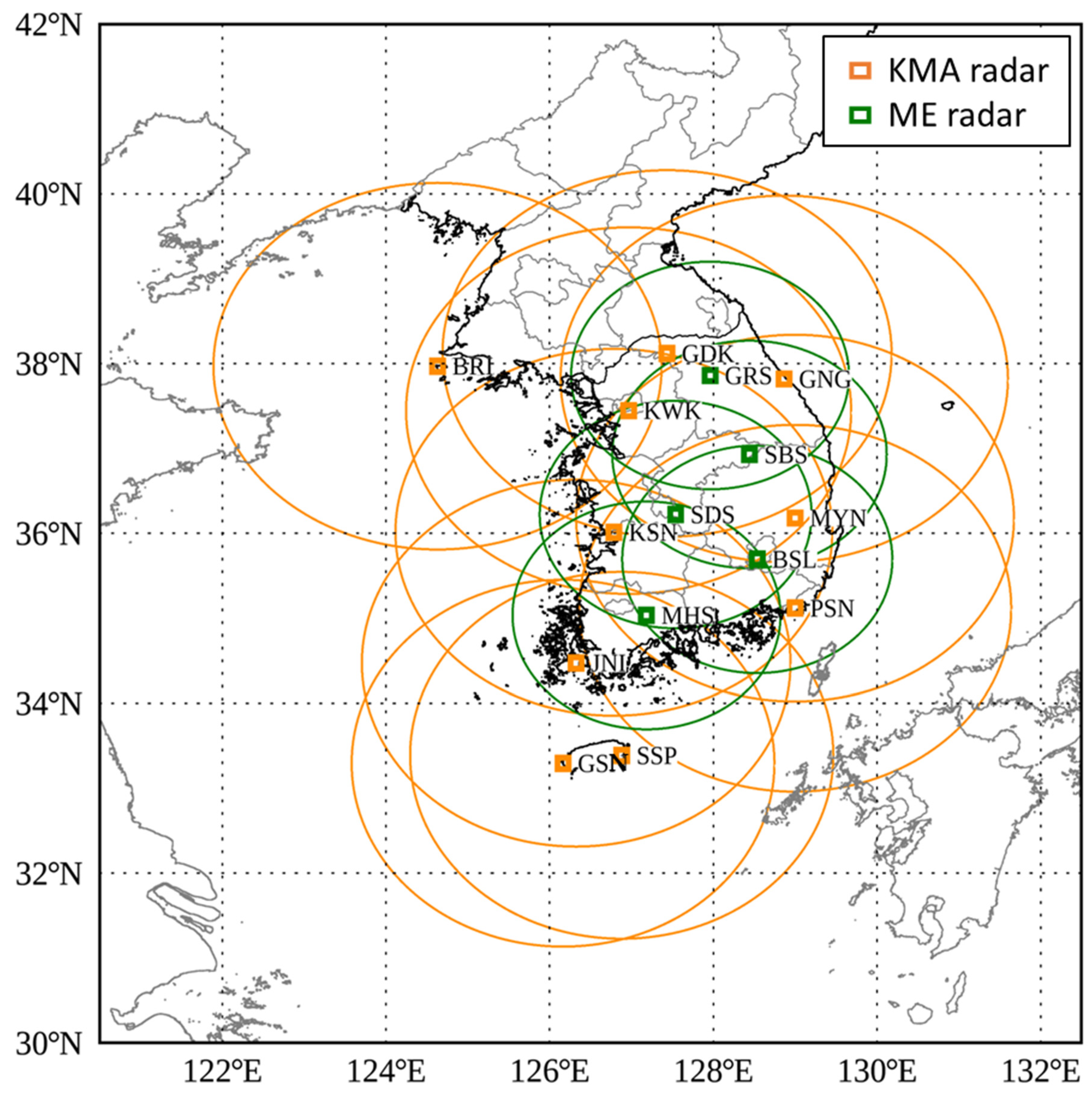


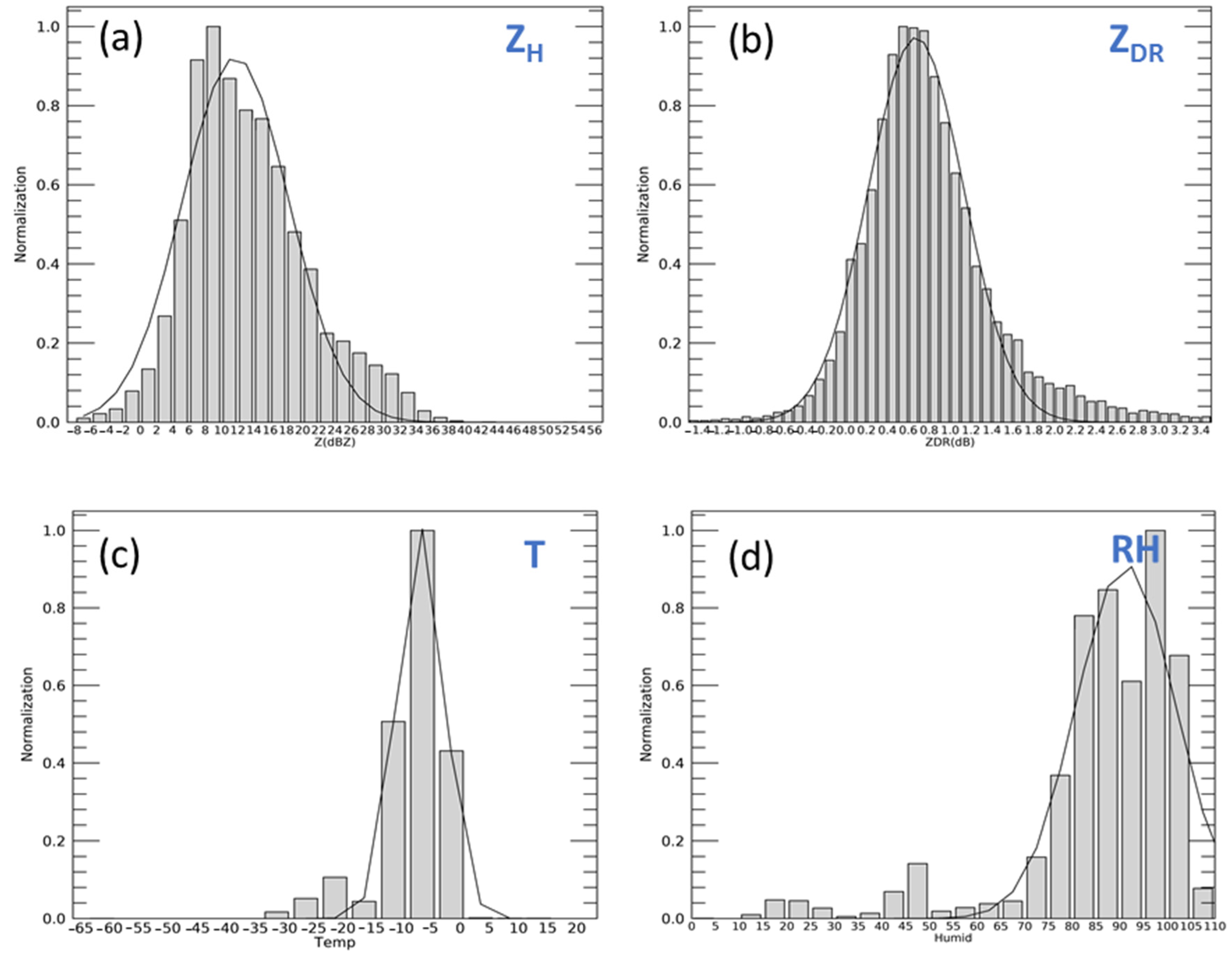

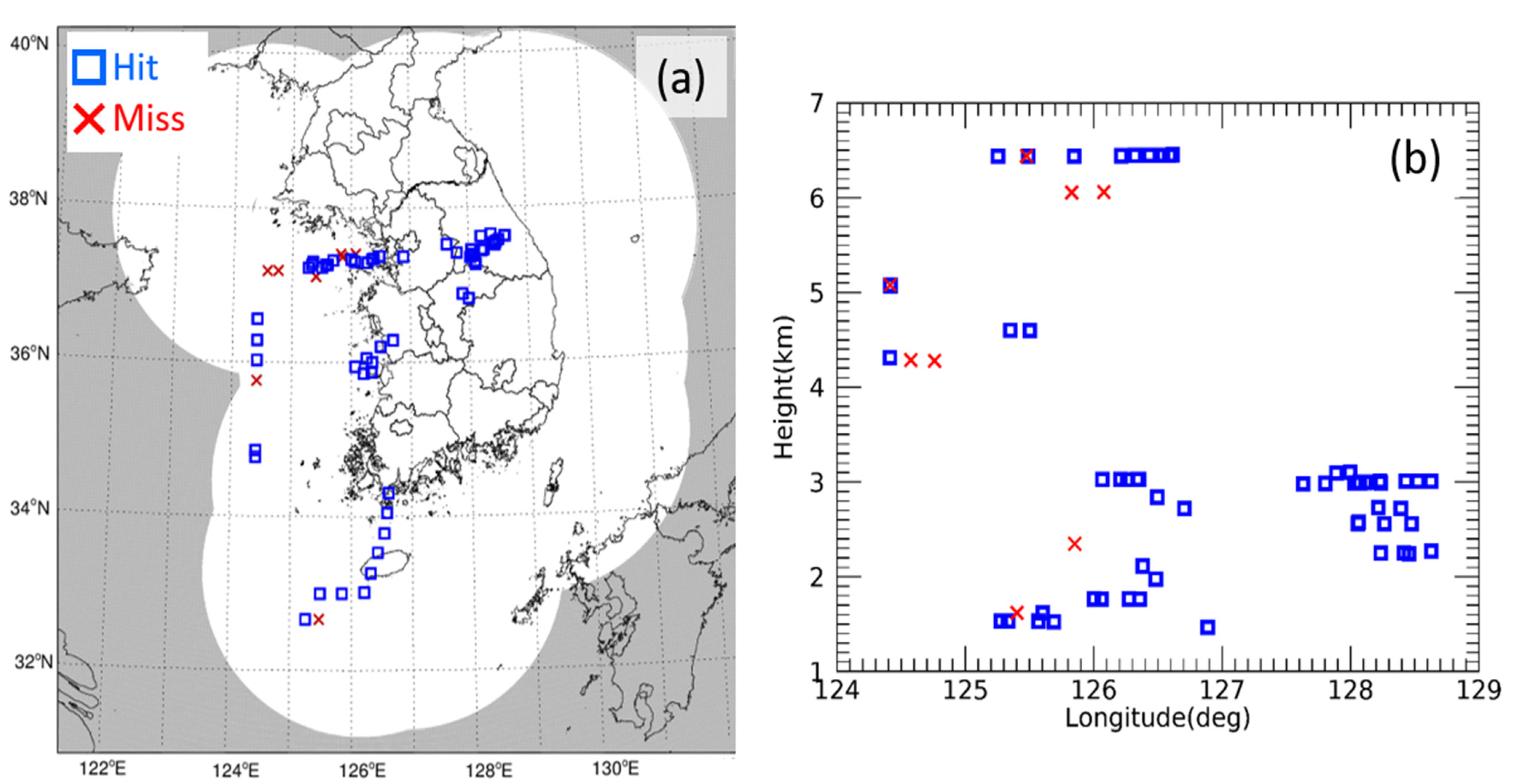
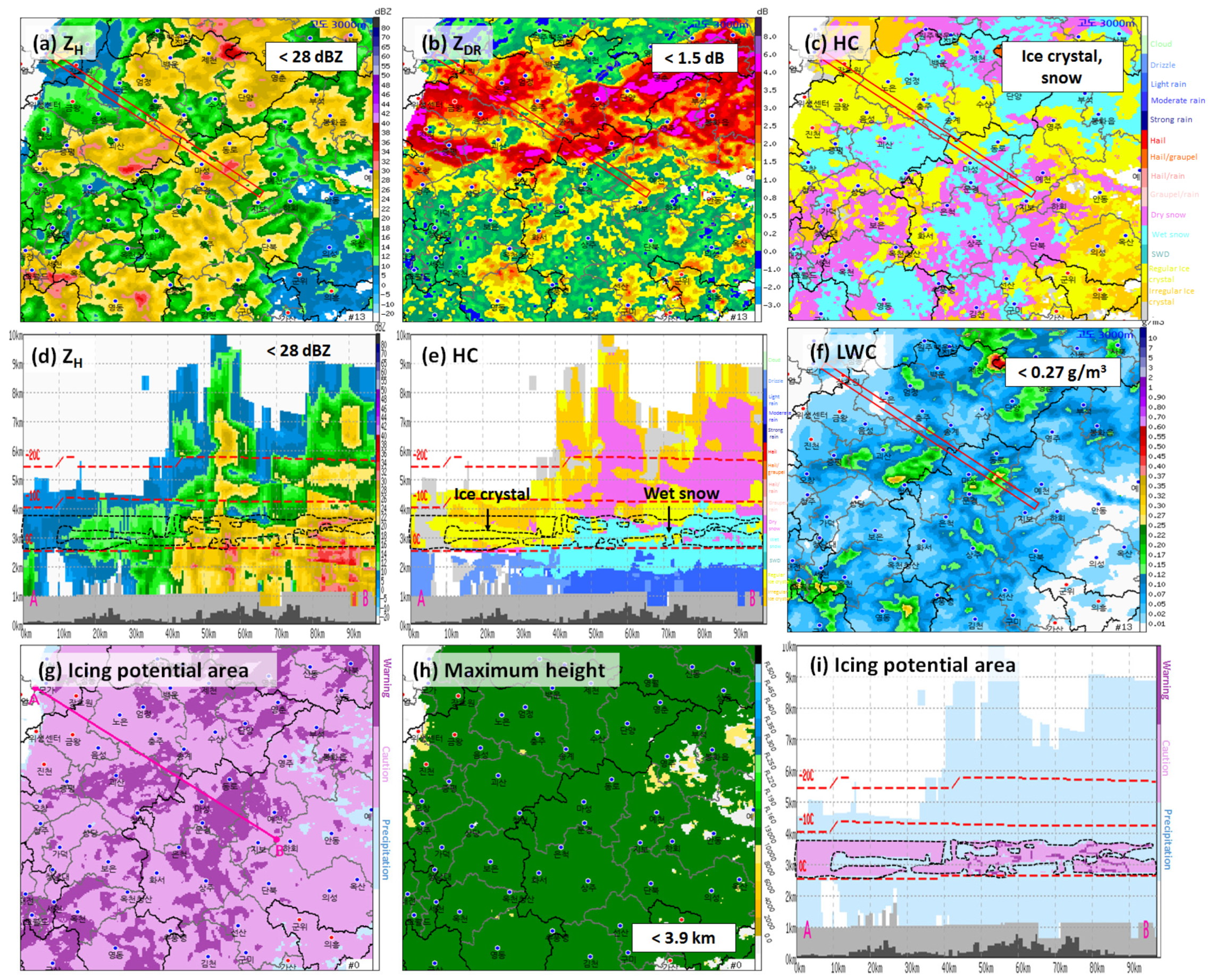
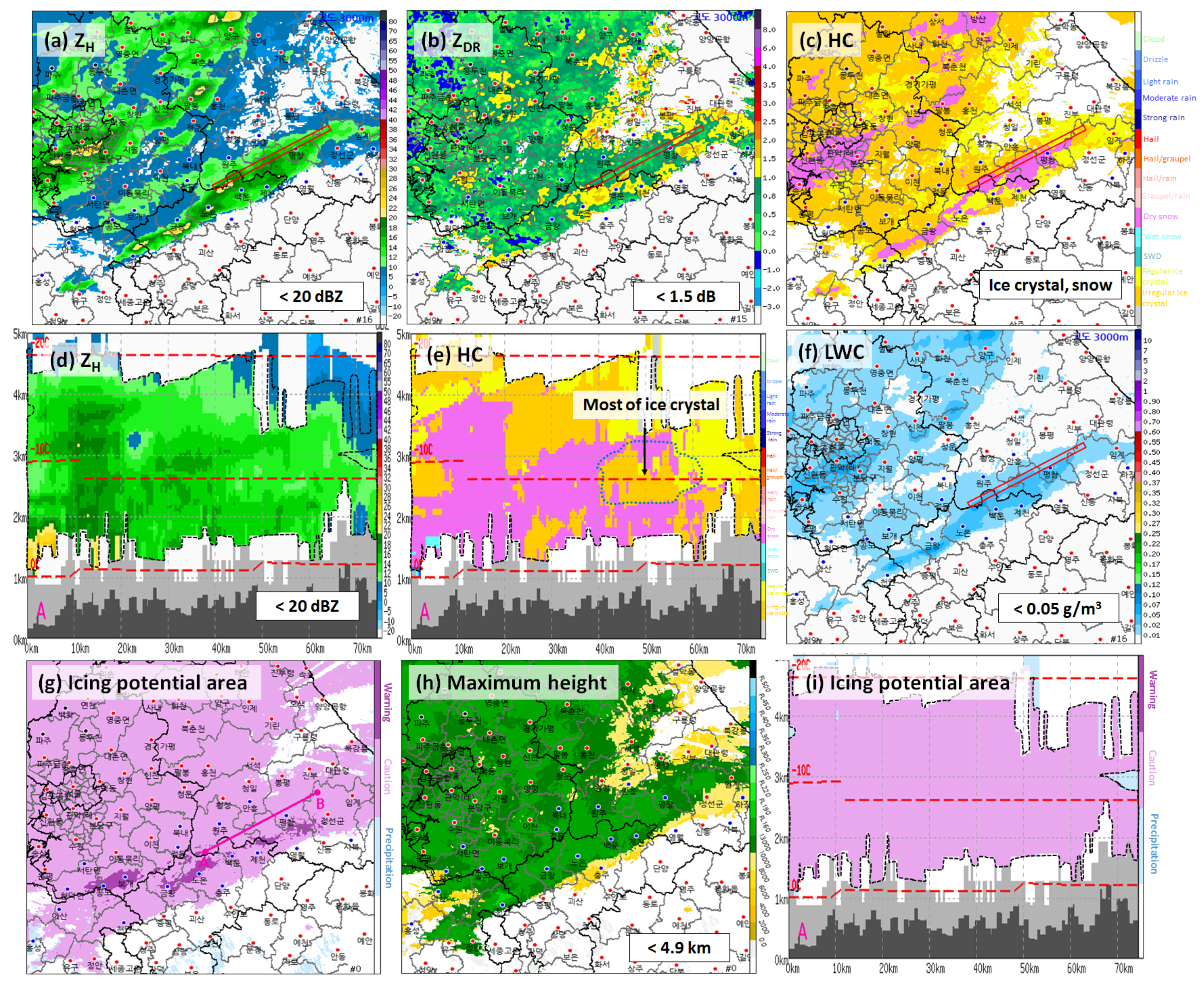

| Algorithm | Data | Output |
|---|---|---|
| Current Icing Potential (CIP) | Radar, satellite, lightning, surface observations, pilot report, numerical model | Potential for icing, SLDs |
| Advanced Diagnosis and Warning systems for aircraft Icing Environments (ADWICE) | Radar, satellite, SYNOP, METAR, local model, station meteorological observation | Aircraft icing |
| Radar Icing Algorithms (RadIA) | Radar, sounding, numerical model, satellite | Aircraft icing |
| Time resolution | 5 min | ||
| Spatial resolution | Horizontal | 0.5 km | |
| Vertical | Altitude (m) | Resolution (m) | |
| 50–8000 | 50 | ||
| 8000–10,000 | 100 | ||
| 10,000–16,000 | 200 | ||
| Number of grid (z,y,x) | (210,2049,2049) | ||
| Time resolution | 5 min | ||
| Spatial resolution | Horizontal | 4 km | |
| Vertical | Altitude (m) | Resolution (m) | |
| 0–3000 | 100 | ||
| 3000–8000 | 200 | ||
| 8000–16,000 | 500 | ||
| Number of grid (z,y,x) | (72,257,257) | ||
| Variables | Condition |
|---|---|
| T | −20 °C ≤ T ≤ 0 °C |
| RH | RH ≥ 70% |
| ZH | −2 dBZ < ZH < 28 dBZ |
| ZDR | −0.6 dB < ZDR < 2.2 dB |
| HC | SWDs, graupel/rain |
| LWC | 0.1 g m−3 < LWC < 2.9 g m−3 |
| Criteria | Area Name | ||
|---|---|---|---|
| Icing Potential | |||
| Icing Caution | Icing Warning | ||
| Number of satisfied conditions | Atmospheric variables (T, RH) | 2 | 2 |
| Radar variables (ZH, ZDR, HC, LWC) | 2 | ≥3 | |
| Icing Potential (Radar) | |||
|---|---|---|---|
| Yes | No | ||
| Aircraft icing observation(Aircraft) | Yes | Hit (H) | Miss (M) |
| No | False (F) | Correct rejection (C) | |
Disclaimer/Publisher’s Note: The statements, opinions and data contained in all publications are solely those of the individual author(s) and contributor(s) and not of MDPI and/or the editor(s). MDPI and/or the editor(s) disclaim responsibility for any injury to people or property resulting from any ideas, methods, instructions or products referred to in the content. |
© 2024 by the authors. Licensee MDPI, Basel, Switzerland. This article is an open access article distributed under the terms and conditions of the Creative Commons Attribution (CC BY) license (https://creativecommons.org/licenses/by/4.0/).
Share and Cite
Kim, Y.; Ye, B.-Y.; Suk, M.-K. AIDER: Aircraft Icing Potential Area DEtection in Real-Time Using 3-Dimensional Radar and Atmospheric Variables. Remote Sens. 2024, 16, 1468. https://doi.org/10.3390/rs16081468
Kim Y, Ye B-Y, Suk M-K. AIDER: Aircraft Icing Potential Area DEtection in Real-Time Using 3-Dimensional Radar and Atmospheric Variables. Remote Sensing. 2024; 16(8):1468. https://doi.org/10.3390/rs16081468
Chicago/Turabian StyleKim, Yura, Bo-Young Ye, and Mi-Kyung Suk. 2024. "AIDER: Aircraft Icing Potential Area DEtection in Real-Time Using 3-Dimensional Radar and Atmospheric Variables" Remote Sensing 16, no. 8: 1468. https://doi.org/10.3390/rs16081468





